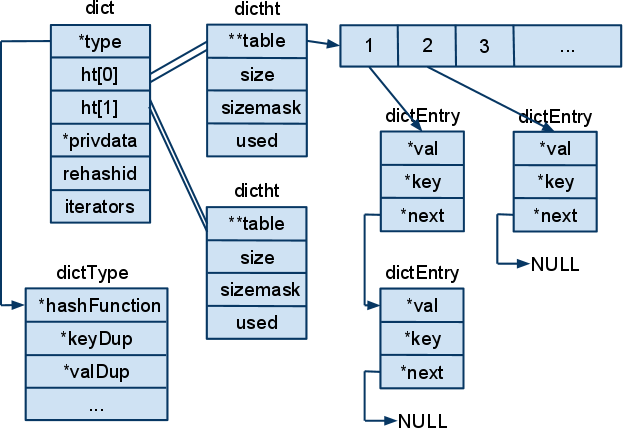Dict和Java中的HashMap很相似,都是数组开链法解决冲突。
但是Redis为了高性能, 有很多比较微妙的方法,例如 数组的大小总是2的倍数,初始大小是4。
rehash并不是一次就执行完,而是分多次执行。每次执行一部分。其中rehashidx表示现在hash到哪一个桶啦,-1表示现在并没有rehash.
dict包含两个dicttable, 编号为0,1, dictht0是直接存储哈希表的地方, dictht1在rehash中用到,当rehashidx不为-1时, 查找key,同时在dictht1和dictht0中查找。
 、
、
数据结构
typedef struct dictEntry { void *key; union { void *val; uint64_t u64; int64_t s64; double d; } v; struct dictEntry *next; } dictEntry; typedef struct dictType { unsigned int (*hashFunction)(const void *key); void *(*keyDup)(void *privdata, const void *key); void *(*valDup)(void *privdata, const void *obj); int (*keyCompare)(void *privdata, const void *key1, const void *key2); void (*keyDestructor)(void *privdata, void *key); void (*valDestructor)(void *privdata, void *obj); } dictType; /* This is our hash table structure. Every dictionary has two of this as we * implement incremental rehashing, for the old to the new table. */ typedef struct dictht { dictEntry **table; unsigned long size; unsigned long sizemask; unsigned long used; } dictht; typedef struct dict { dictType *type; void *privdata; dictht ht[2]; long rehashidx; /* rehashing not in progress if rehashidx == -1 */ int iterators; /* number of iterators currently running */ } dict; /* If safe is set to 1 this is a safe iterator, that means, you can call * dictAdd, dictFind, and other functions against the dictionary even while * iterating. Otherwise it is a non safe iterator, and only dictNext() * should be called while iterating. */ typedef struct dictIterator { dict *d; long index; int table, safe; dictEntry *entry, *nextEntry; /* unsafe iterator fingerprint for misuse detection. */ long long fingerprint; } dictIterator; typedef void (dictScanFunction)(void *privdata, const dictEntry *de);
查找key
dictEntry *dictFind(dict *d, const void *key) { dictEntry *he; unsigned int h, idx, table; if (d->ht[0].size == 0) return NULL; /* We don't have a table at all */ if (dictIsRehashing(d)) _dictRehashStep(d); h = dictHashKey(d, key); for (table = 0; table <= 1; table++) { idx = h & d->ht[table].sizemask; he = d->ht[table].table[idx]; while(he) { if (dictCompareKeys(d, key, he->key)) return he; he = he->next; } if (!dictIsRehashing(d)) return NULL; } return NULL; }
redis的rehash是增量rehash,每次rehash一部分
rehash过程:
1. 从 dictht0的table 0到----N-1查找不为NULL的位置(非空桶)
2. 对该位置的链表进行处理, hash到dictht 1的table 1中。
rehash的函数,设置了n参数,表示要处理的非空桶的个数,但是在函数内部设置了最多访问10*n个空桶。
int dictRehash(dict *d, int n) { int empty_visits = n*10; /* Max number of empty buckets to visit. */ if (!dictIsRehashing(d)) return 0; while(n-- && d->ht[0].used != 0) { dictEntry *de, *nextde; /* Note that rehashidx can't overflow as we are sure there are more * elements because ht[0].used != 0 */ assert(d->ht[0].size > (unsigned long)d->rehashidx); while(d->ht[0].table[d->rehashidx] == NULL) { d->rehashidx++; if (--empty_visits == 0) return 1; } de = d->ht[0].table[d->rehashidx]; /* Move all the keys in this bucket from the old to the new hash HT */ while(de) { unsigned int h; nextde = de->next; /* Get the index in the new hash table */ h = dictHashKey(d, de->key) & d->ht[1].sizemask; de->next = d->ht[1].table[h]; d->ht[1].table[h] = de; d->ht[0].used--; d->ht[1].used++; de = nextde; } d->ht[0].table[d->rehashidx] = NULL; d->rehashidx++; } /* Check if we already rehashed the whole table... */ if (d->ht[0].used == 0) { zfree(d->ht[0].table); d->ht[0] = d->ht[1]; _dictReset(&d->ht[1]); d->rehashidx = -1; return 0; } /* More to rehash... */ return 1; }
和adlist一样,dict也有迭代器
迭代方法如下:
dictEntry *dictNext(dictIterator *iter) { //对表的桶进行遍历,直到找到一个非空桶,返回 while (1) { if (iter->entry == NULL) { dictht *ht = &iter->d->ht[iter->table]; if (iter->index == -1 && iter->table == 0) { if (iter->safe) iter->d->iterators++; else iter->fingerprint = dictFingerprint(iter->d);//对dict进行指纹 } iter->index++; //如果迭代到表的最后一个桶,就判断要不要迭代第二个表 if (iter->index >= (long) ht->size) { if (dictIsRehashing(iter->d) && iter->table == 0) { iter->table++; iter->index = 0; ht = &iter->d->ht[1]; } else { break; } } iter->entry = ht->table[iter->index]; } else { iter->entry = iter->nextEntry; } if (iter->entry) { /* We need to save the 'next' here, the iterator user * may delete the entry we are returning. */ iter->nextEntry = iter->entry->next; return iter->entry; } } return NULL; }
Dict的API如下:
/* API */ /* 字典创建, type参数制定各类对字典的自定义函数,会初始化dictht, dict */ dict *dictCreate(dictType *type, void *privDataPtr); int dictExpand(dict *d, unsigned long size); /* 添加键值对,内部调用addRaw和setvalue ,如果已经存在,返回NULL*/ int dictAdd(dict *d, void *key, void *val); /* 添加键 ,如果已经存在,返回NULL*/ dictEntry *dictAddRaw(dict *d, void *key); /* 添加一个key,如果存在,直接设置value,设置key的value */ int dictReplace(dict *d, void *key, void *val); /* 添加一个key,如果存在,直接返回 */ dictEntry *dictReplaceRaw(dict *d, void *key); /* 删除一个节点,需要free那个节点 */ int dictDelete(dict *d, const void *key); /* 删除一个节点,不需要free那个节点 */ int dictDeleteNoFree(dict *d, const void *key); /* 删除dict*/ void dictRelease(dict *d); /* 查找key*/ dictEntry * dictFind(dict *d, const void *key); /* 查找key的value*/ void *dictFetchValue(dict *d, const void *key); /* 将dict的size设置和元素数量一样,但是符合2的倍数*/ int dictResize(dict *d); dictIterator *dictGetIterator(dict *d); dictIterator *dictGetSafeIterator(dict *d); dictEntry *dictNext(dictIterator *iter); void dictReleaseIterator(dictIterator *iter); dictEntry *dictGetRandomKey(dict *d); unsigned int dictGetSomeKeys(dict *d, dictEntry **des, unsigned int count); void dictPrintStats(dict *d); unsigned int dictGenHashFunction(const void *key, int len); unsigned int dictGenCaseHashFunction(const unsigned char *buf, int len); void dictEmpty(dict *d, void(callback)(void*)); void dictEnableResize(void); void dictDisableResize(void); int dictRehash(dict *d, int n); /* rehash,设置一个最长时间*/ int dictRehashMilliseconds(dict *d, int ms); void dictSetHashFunctionSeed(unsigned int initval); unsigned int dictGetHashFunctionSeed(void); unsigned long dictScan(dict *d, unsigned long v, dictScanFunction *fn, void *privdata);
上面的API很多函数内部都会判断当前是不是还在rehash状态,如果是,就rehash一步。
在rehash前,会判断是不是有迭代器存在,如果有迭代器存在,就不rehash
static void _dictRehashStep(dict *d) {
if (d->iterators == 0) dictRehash(d,1);
}